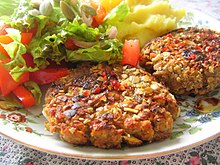Before you become too alarmed (no pun intended here), read the entire article. Yes, we do have something to be worried about when we see that there is a flame retardant in our food but without more information, we really need to research.
My first thought about this article was, "OMG, now I have to worry about one more thing that I eat!" Well, that is true that I should always be conscience about what ingredients are in my food but also to read the entire article before making rash judgements. Yes, the flame retardant in the paper could seep into our food, but it's not in all packaging, that we know of, and it's not an ingredient.
Lesson learned, read to the end and keep shopping organic and local as much as possible. That way, at least, I know where my food is packaged so that if there is a problem, I can go to the source. Also, big corporations are going to take the least expensive route so I'm sticking with my tried and true local dairy!
Pants On Fire? Put Them Out With...Butter?
 The next time you're looking to fireproof something forget trekking down to the hardware store, instead check the fridge and grab a stick of butter. Researchers have found varied amounts of flame retardant in sticks of butter.
The next time you're looking to fireproof something forget trekking down to the hardware store, instead check the fridge and grab a stick of butter. Researchers have found varied amounts of flame retardant in sticks of butter.Polybrominated dphenyl ethers, or PBDEs, are a class of chemicals commonly used in furniture and electronic manufacturing as flame-retardants. When digested these chemicals have been known to stop hormone function and increase cancer risk. "Flame retardants were not made to be eaten," said Arnold Schecter, one of the researchers. "They're made to slow down the smoke in fires. They're not a food component. They don't belong there." Just in case that was unclear. They have also been associated with reproductive, developmental and neurological problems. This is the first documented case of PBDEs being found in food in the US.
U.S. researchers tested a selection of ten kinds of butter sourced from Dallas grocery stores. Nine of the samples showed small amounts of the contaminant, which is consistent with the results of previous studies as PBDEs can enter foods through soil, water and air. But one sample had levels of PBDEs that were 135 times that of the others. The source of the contaminants was traced to the wrapper. Though Shecter will not release the name of the company whose butter contained such high levels of the chemicals, he believes that the issue could be due to an electrical incident. If there was a fire in one of the machines or overheating, the chemicals could have leaked into the paper and then later into the butter.
Currently, there are no federal agencies tracking levels of chemicals like PBDEs in food so there is no way to know how widespread this sort of contamination is. The newly Senate-approved Food Modernization Safety Act would not be able to help as it focuses on bacteria rather than chemicals. Though it is unlikely that the sample with high levels of PBDEs is the only contaminated stick out there, it is also unlikely that there is a large quantity of the sticks. (If you feel like doing a little detective work to find out the exact brand of butter, Schecter says that the company's headquarters are in the Minneapolis-St. Paul area). These types of chemicals are also nothing new to our systems. "We basically have all of these chemicals in our bodies just from being in an indoor environment and from eating," Schecter said. "You're certainly not going to be able to control that by being careful about what kind of butter you buy." Schecter and the other researchers believe that their research emphasizes the need for a government-regulated program to test foods for contaminants like PBDEs.
How do you feel about these findings? Are you going to switch to Country Crock? Or will you throw caution into the wind and continue to give yourself a little pat of butter?
Photo Credits: jessicafm / flickr, jessicafm / flickr


 via
via 


